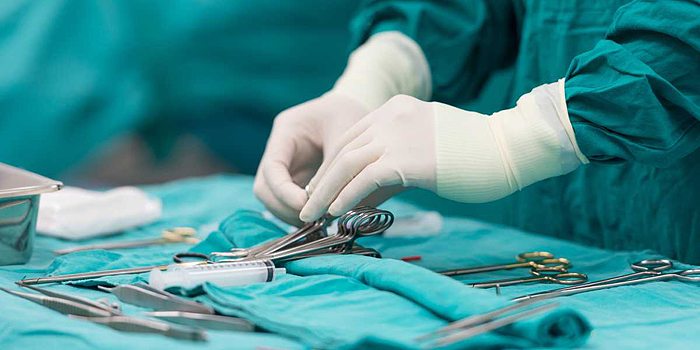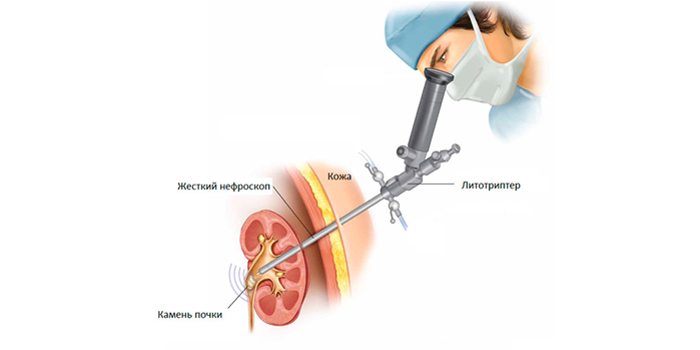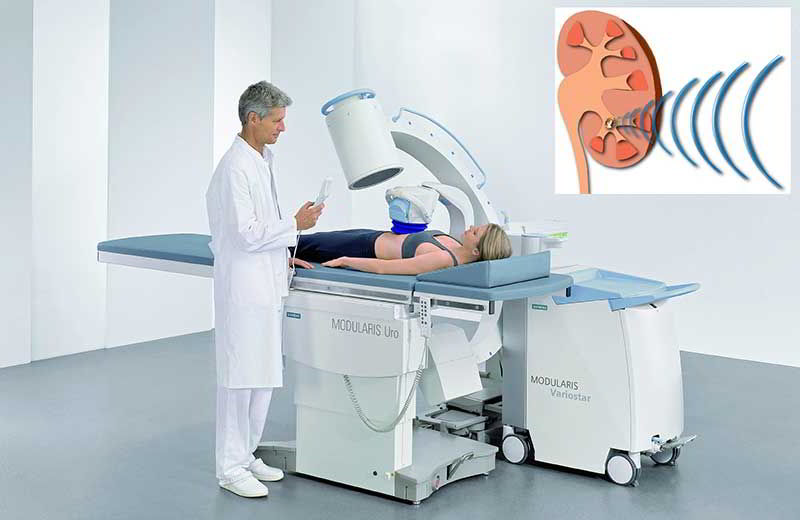Nephrolithiasis, (urolithiasis) is dangerous not only for its chronic progressive course, but also for serious complications associated with an infectious and inflammatory lesion renal tissue, the release of stones and a violation of the normal outflow of urine. Removal of kidney stones is one of the main ways to treat pathology. Today it is carried out various methods depending on a number of factors. To choose modern technology that will effectively and safely remove salt formations, you need to consult a doctor and undergo a comprehensive examination.
Percutaneous nephrolithotripsy is the ideal operation for larger kidney stones, usually larger than 20 mm. During the operation in lumbar region a small cut is made to insert a device called a nephroscope into the kidney. This device has a micro-camera that allows the doctor to locate stones and fragment them with a laser. These small pieces are removed with special tweezers.
The operation is carried out under general anesthesia. Due to the small incision and the use of probes, the patient returns home two to three days after the procedure. At home, rest should last about a week without any physical activity. Less and less used nowadays, conventional or open surgery consists of opening the kidney to remove the stones. It is the most invasive and can lead to consequences that are considered to be the most serious cases in which other procedures cannot be applied.
Attention to the patient
Before the question of which procedure should be used to remove a kidney stone from a particular patient with KSD is decided, a number of factors are taken into account:
- size, localization and number of stones;
- their chemical structure;
- anatomical features of the structure of the ureters;
- absence/presence of obstruction at all levels of the urinary tract;
- age, general condition and well-being of the patient;
- severity of pathological symptoms of nephrolithiasis;
- possible comorbidities.
The decision on how to remove stones from the kidneys is made taking into account all the information received by the doctor during the conversation with the patient, examination, as well as laboratory and instrumental examinations. The most efficient and safe way fight the disease.
Laparoscopic surgery is performed through small openings in abdominal cavity and can be successfully used in specific cases - for calculations located in the area called the renal pelvis. Done with general anesthesia and hospitalization for approximately 3 days.
Learn about kidney stones
Also urine waste. When they are not able to process toxins effectively, they end up leading to uncomfortable kidney stones. Home and natural remedies may help expel kidney stones. These stones are nothing but chemical urine such as uric acid, phosphorus and oxalic acid.
Exist different methods. Conventionally, they can be divided into non-invasive and invasive.
Non-invasive techniques
Non-invasive treatment is preferable as it allows kidney stones to be removed without surgery. However, this type of therapy is used only in the case of small stones - up to 4 mm, since formations of a larger diameter can injure the urinary tract.
Regardless of the size of the stone, this can cause severe pain. Other symptoms include a desire to urinate frequently, pain when urinating, nausea, vomiting, and excessive sweating. In addition to conventional medications, most cases can be treated with natural remedies, which can also help prevent this problem.
Check out the best home remedies for treating kidney stones
Next to the treatment, you need to drink a lot, from eight to ten glasses of water. See what are the best home remedies for kidney stones. To treat a kidney stone, put watermelon on your shopping list. Watermelon - great way deal with this problem as it contains calcium, magnesium, phosphate and carbonates. The potassium present in watermelon is an important ingredient for maintaining kidney health as it helps regulate and maintain acid levels in the urine.
The appointment of diuretics and an increase in the amount of fluid consumed by a person. This simple method is used to wash the kidneys with water and remove the formed pebbles and sand from the body. Every day it is recommended to drink up to 2-2.5 liters of non-mineral water, unsweetened fruit drink from cranberries, lingonberries. The selection of the dosage and duration of taking diuretic drugs is carried out individually by a nephrologist. Purpose medicines.
Along with potassium, watermelon also contains high concentration water which helps in releasing kidney stones. Regular consumption of watermelon can help in the treatment as well as in preventing the formation of these stones. Because of high content protein, beans can be effective in treating any type of kidney or bladder problems. To do this, place the beans in hot water. Let the water simmer for a few hours until the beans are soft.
Strain the liquid and let it cool and drink several times throughout the day to relieve kidney pain. This liquid should not be stored for more than 24 hours as it will lose its therapeutic properties. You can also include beans in your diet. Basil can help trigger kidney stones through urinary tract. Mix one teaspoon of basil and another of honey. If you don't like the taste of honey, you can take pure juice basil or chew three basil leaves a day.
Phytolysin, Urolesan, Kanefron, Cyston, Fitolita - the action of which is aimed at dissolving kidney stones and their natural excretion with urine. In addition to the direct effect on already formed stones, these drugs:
- prevent the crystallization of mineral components in the urine;
- relieve inflammation;
- prevent the formation of edema;
- increase daily diuresis.
Note! Non-drug treatment Phosphate and urate kidney stones are better exposed. At the same time, oxalate calculi, which are found in medical practice most often removed surgically.
Surgical treatment

And how to deal with kidney stones, if their diameter significantly exceeds the "permissible" 4-5 mm and is several centimeters? In this case it is required. Surgical removal stones is shown at:
Another option is to drink basil tea. To do this, simply boil a few basil leaves in water for about 10 minutes. Add a teaspoon of honey. Combination lemon juice and olive oil traditionally used to remove gallstones, but it can also be used to treat kidney stones. The citric acid present in lemon helps break up stones and prevent their growth.
To do this, mix four tablespoons of fresh lemon juice with an equal amount of extra virgin olive oil. Drink this mixture followed by plenty of water. Do this two or three times a day. The key is to stay well hydrated! Drinking fluids is a key habit naturally eliminate stones that are in the kidneys and prevent the formation of new ones.
- severe pain in the lower back, which causes the pressure of the stone on the kidney tissue;
- violations of the physiological outflow of urine;
- development CKD symptoms and disorders of the renal blood flow;
- the appearance of hematuria (blood in the urine) associated with damage to the moving calculi of the urinary tract;
- the development of infectious and inflammatory complications of the KSD.

Percutaneous access involves the removal of stones through a small incision in the lower back using a special endoscopic instrument - a nephroscope. Such a method surgical intervention allows you to perform both nephrolithotomy (removal of the calculus entirely) and nephrolithotripsy (extraction of the stone after its preliminary crushing).
The fluid not only eliminates toxins, but also helps to remove these stones and "sand" through the urinary tract. While enough water is enough to do the magic, adding some ingredients can make it even more effective. Be sure to drink 240 ml of water immediately after taking any product that contains some kind of fragrance - this can help remove the compounds through the body.
Talk to your doctor before you start using any of the home remedies listed below. Only a doctor can judge if your home treatment is right for you or if it could lead to other complications. If you are pregnant or breastfeeding, use any of the following home remedies with caution.
Benefits of this kidney stone treatment method:
- extensive experience in medical practice - percutaneous calculus removal is considered the "gold standard" of therapy;
- high efficiency (95%) even with big size stones;
- for complete cure one procedure is enough;
- reliability and efficiency - this type of surgical intervention is most often used in urology.
Transurethral stone removal
During transurethral nephrolithotripsy, a kidney stone is removed using special endoscopic equipment inserted into the urinary tract through the urethra - a ureteronephroscope. This minimally invasive technique is carried out under the general or local anesthesia, and consists of several stages:
If you have questions, ask your doctor. Only he can determine if any of the juices listed may cause side effects on you or your child. Increasing water intake can speed up the process of water removal. Aim to take 12 glasses of water a day instead of the usual 8.
Dehydration is one of the main risk factors for formation - and the last thing you want is the formation of new stones. In addition, citrate also reduces the size of stones, making them easier to remove. Apple cider vinegar contains citric acid, which helps expel kidney stones in addition to alkalizing the blood and urine and increasing the acids present in the stomach to prevent new stones from forming.
- Conducting a ureteronephroscope to the location of the calculus.
- Bringing instruments for stone removal through a special channel in endoscopic equipment.
- Removal of the calculus: if the diameter of the formation is small, a nephrolithotomy is performed, with a significant size of the calculus, the doctor crushes it into smaller pieces, and then removes it with the help of tools.
Benefits of transurethral stone removal:
In addition to cleaning the kidneys, Apple vinegar still relieves pain caused by stones. Drink the mixture throughout the day. Do not consume more than one 240 ml glass of this mixture per day. When ingested in large quantities, apple cider vinegar can also cause a decrease in potassium levels.
People with diabetes should be careful when consuming the mixture. Monitor your blood sugar throughout the day. Do not drink the mixture if you are consuming. Digoxin such as spironolactone. . If you find them fresh, you can also add orange peel to taste.
Drink 3-4 cups throughout the day. Some people get heartburn when they ingest dandelion. Do not drink juice if you do. Diuretic diluents such as spironolactone. . If you are taking medication, talk to your doctor before taking the extract, as it can interact with many medications.
- the method actively fights small and medium-sized calculi;
- successfully used to treat patients with chronic cardiovascular diseases, as it does not require the abolition of blood-thinning agents (unlike other types of surgery);
- carried out on an outpatient basis;
- does not require violation of the integrity of the skin and mucous membranes.
Laparoscopic and open surgery

At present, large abdominal operations were almost completely superseded by minimally invasive endourological methods of treatment. Laparoscopy and interventions through open surgical access are performed with:
The plant also contains antibacterial and antioxidant properties that improve overall urine health. You should also not drink this juice if you fall into the following conditions. Nature offers all the resources to cure diseases, including several options home treatment kidney stones, a disease recognized as a cause of severe seizures and impaired functioning Bladder. This problem, which causes severe pain, requires caution.
Best Home Remedies for Kidney Stone
Anyone who has kidney stones needs medical supervision. If you have kidney pain, it may be for surgery and medical care. Only your doctor can tell you if surgery is needed. Here are some home remedies for kidney stones that are helpful in treating symptoms and easing side effects some medicines.
- gigantic size of the stone;
- malformations of the urinary tract, not allowing for endoscopic surgery.
Despite being 100% effective, radical invasive surgery is dangerous long recovery patient and high risk development of complications after removal of the calculus. Today it is extremely rare.
Perhaps this is the best home remedy for a kidney stone. This herb is one of the most used for the treatment of kidney stones, as its name is already known for its effectiveness. Once it starts to boil, turn off the heat and add climbing grass; Dilute the container and let it rest for 10 minutes, as a result of which the water will absorb the properties of the plant well; Strain the tea, store the liquid in a container with a lid and take throughout the day. Put the water in heat. . It is recommended to take 3 cups of this tea daily.
Kidney stones can be compared to a time bomb. Long time they do not declare themselves, but one day they will lead to serious complications. Therefore, it is important to remove them in a timely manner - the main method of treatment. urolithiasis.
After surgery and a short recovery period, patients with nephrolithiasis are advised to eat right, observe drinking regimen, be physically active, treat in a timely manner infectious diseases bodies urinary system. These activities will normalize the disturbed metabolism and prevent the possibility of the development of new stones.
Many people don't know, but this good alternative among home remedies for kidney stones. In addition to having diuretic properties, stimulating the elimination of impurities in the kidneys, horsetail is anti-inflammatory, reducing pain in the urinary tract caused by stones.
When it begins to boil, add the horsetail herb and turn off the heat; Cover the container and let the tea cool for 10 minutes; Strain, put the liquid in a container with a lid and drink throughout the day. Parsley is another great home remedy for kidney stones as it cleanses the organ and eliminates all the impurities accumulated in the urine.
Modern urology is constantly trying to solve the problem: "how to remove stones from the kidneys in a minimally traumatic way?" and thanks to this, new methods of treating urolithiasis appear every year. To date, there are two fundamentally different approaches to removal - conservative (medication), instrumental and surgical (classical and minimally invasive).
Wash the parsley branches well; In a blender, put parsley and water; Beat well, strain and drink the whole Fresh Juice. ½ bunch of fresh parsley; ½ liter of ice water. . Note: This juice should be swallowed within 4 days of fasting. Thanks to the antibacterial and astringent properties found in burdock, it is another of the most recommended medicinal plants for the treatment of kidney stones.
Once it starts to boil, add burdock root and boil for 5 minutes; Turn off the fire, suffocate the tea and let it sit for 5 minutes; Strain and drink immediately after. It is recommended to drink 2 to 3 cups of this tea throughout the day until the symptoms of kidney stones disappear.
Conservative removal of a stone in the renal pelvis can be ascending and descending. The essence of the top-down method of stone dissolution is to take medicines inside (parenteral), and ascending, in topical application special medications. It should be noted that downward litholysis () can only be prescribed for uric acid urolithiasis. For these purposes, Eisenberg's mixture is used. It is prepared by mixing 40 g citric acid, 60 g sodium citrate, 600 ml sugar syrup, 6 g of orange root tincture and potassium citrate 70 g. 5 ml is used, 3 times a day, for 6 months.
Green tea, rich in diuretics and astringents, is an excellent natural remedy both for the prevention and treatment of kidney stones. Once it starts to boil, turn off the heat and add green tea into the grass; Dimension the mixture and wait 10 minutes until it cools down and the water absorbs the properties of the plant; Rise, add lemon and drink tea throughout the day. It is recommended to take 2 cups of this tea daily.
Food as home remedy for kidney stone
It consists of one of the most effective natural antibiotics, acting to reduce the pain caused by inflammation caused by kidney stones and promote the elimination of toxins responsible for the formation of these stones. In a container, put water with ginger, set on fire and let the mixture boil for 10 minutes; Turn off the heat, add honey and suffocate the tea for 10 minutes; Dip and drink throughout the day and it is recommended to take 3 cups of this daily. In addition to the benefits of the aforementioned remedies, it is important to put some foods on the menu that promote kidney health.
Besides medicine, high efficiency show the following drugs: Uralit-U, Blemaren, Soruran, Alkalit, Solymok, Magurlit. In parallel with the use of these medicines, it is necessary to constantly monitor the pH of the urine, which should be 7.0–6.5. The imbalance leads to the formation and precipitation of calcium phosphates, which form a protective shell on the stone, making it difficult to dissolve. Radiologically, such a process is visualized as a rounded calculus with a well-defined core in the middle. The control of urine pH is carried out by the patient himself with the help of special litmus papers with a scale.
When urine always has an alkaline reaction, therefore, ammonium chloride and citrate, methionine (0.5 g - 3 times a day), ammonium phosphate (1 g - 4 times a day) are used to dissolve them. When o apply magnesium salt 150 mg 2-3 times a day.
Recently, ascending dissolution of stones using a double-lumen urinary catheter Dormian is often used. The essence of this method is that lithotripsy fluid enters the renal pelvis on one side of the tube, and flows out on the other. For these purposes, special solutions containing chelates (trilon B, oxalate) are used. The latter are able to give other elements instead of calcium ions, which leads to the destruction of the stone. The solution must be at a certain temperature (37–38 degrees).
Instrumental Methods
 Among instrumental methods needs to be highlighted. Its essence lies in the fact that a special sighting device is aimed at the formation area, followed by ultrasound radiation. Such waves are in contact with the calculus at a certain frequency. Both during the procedure and after it, a slow destruction of the formation occurs. Crushed fragments descend into the ureter and out with the flow of urine.
Among instrumental methods needs to be highlighted. Its essence lies in the fact that a special sighting device is aimed at the formation area, followed by ultrasound radiation. Such waves are in contact with the calculus at a certain frequency. Both during the procedure and after it, a slow destruction of the formation occurs. Crushed fragments descend into the ureter and out with the flow of urine.
Indications for this treatment method:
- the presence of a size up to 25 mm with obligatory patency of the lower urinary tract;
- multiple kidney stones up to 30 mm;
- coral-like stones up to 40 mm and without dysfunction of the organ.
General contraindications:
- large weight of the patient;
- the impossibility of precise guidance of the shock wave on the calculus;
- obstruction of the urinary tract;
- severe deformity of the spine;
- blood clotting disorder;
- pregnancy;
- acute pathologies of the cardiovascular system;
- aneurysm of the aorta or renal arteries;
- thrombophlebitis of the lower extremities;
- malignant tumors of the abdominal cavity;
- ulcers in the digestive tract;
- diabetes;
- active tuberculosis;
- diseases of the central nervous system.
Local contraindications:
- inflammatory process in the urinary organs;
- a large amount of blood in the urine;
- renal venous insufficiency;
- leukocytes in the urine (about 100 or more);
- severe bacteriuria;
- the presence of a stone in the ureter at the same level for more than 4 weeks;
- the calculus completely covers the lumen of the urinary tract;
- renal polycystic;
- tuberculosis of the urinary system;
- malignant tumor in the pelvic area;
- azotemia.
Surgical methods
 Surgical interventions are considered highly effective, but at the same time they have clear indications for carrying out. These include:
Surgical interventions are considered highly effective, but at the same time they have clear indications for carrying out. These include:
- Frequent bouts of colic that affect a person's ability to work.
- Persistent violation of the outflow of urine, leading to swelling of the kidney.
- Frequent diseases with pyelonephritis, which leads to the development of renal failure.
- Purulent inflammation of the kidney (abscess, carbuncle, festering cyst).
- A calculus in one kidney or ureter that interferes with the flow of urine.
Among the classical surgical interventions, it is necessary to single out organ-preserving and radical methods. Total removal of the organ (nephrectomy) is used as a necessary measure and also has its indications: calculous pyonephrosis, hydronephrotic transformation of the kidney in the extreme stage, apostematous pyelonephritis. These indications are the main ones, since there are many times more of them and it all depends on general condition sick.
Among organ-preserving surgical interventions, it is necessary to distinguish two main types - nephrotomy and resection. The essence of these methods is that after opening the organ, the calculus is removed from further recovery its integrity and, if necessary, its drainage. It should be noted that before and after the surgical intervention, a supporting drug therapy.
It is necessary to add that after organ-preserving procedures in many cases it is required reoperation. This is associated with recurrence of nephrolithiasis and secondary blockage of the urinary tract.
One of modern methods treatment of calculi, especially staghorn calculi, is considered percutaneous (percutaneous) nephrolithotripsy. It's minimally invasive surgical intervention is carried out by the formation of a puncture fistula of the pyelocaliceal system and the removal of a calculus through its channel under endoscopic control. The most commonly used is ultrasonic lithotripsy. To perform such a manipulation, rigid nephroscopes, various loops, clamps, an ultrasound generator and a special tip that generates waves are used.
The procedure begins after the nephrostomy is performed, and after a few days the nephrostomy tube is removed, followed by the introduction of a small tube into its lumen. optical system. After that, crushing of the calculus begins under the control of this optical system. Larger stones are removed using loops and clamps, or they are crushed and then washed out. The nephrostomy tube is left in place for several days after the operation.
Kidney stones can be removed with medication, instrumental and surgically, but most effective methodology considered minimally invasive surgery.





